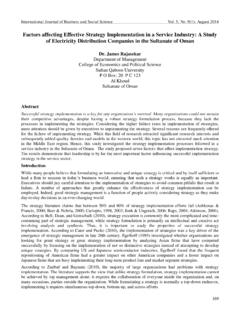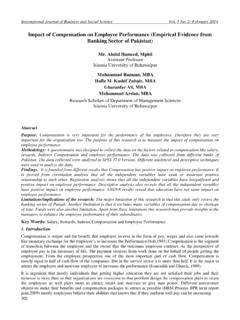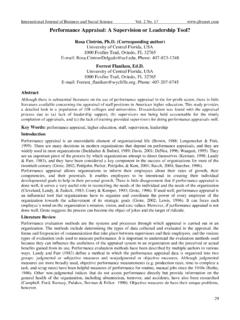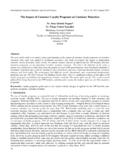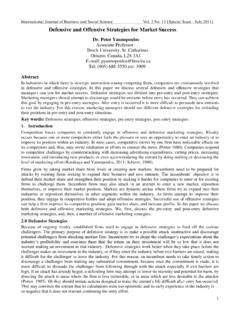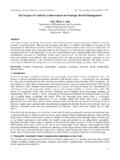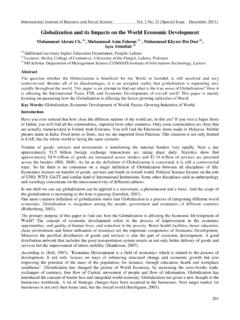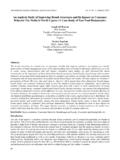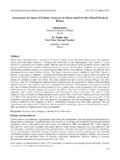Transcription of The Impact of Organisational Culture on Performance of ...
1 International Journal of Business and Social Science Vol. 3 No. 8 [Special Issue - April 2012] 211 The Impact of Organisational Culture on Performance of educational institutions Muya James Ng ang a Lecturer Moi University 591 Kisii Kenya Wesonga Justus Nyongesa Lecturer Narok University College 534 Kisii Kenya Abstract Every organization has a Culture -good or bad. However there is more to a good Culture than happy staff. In order to aid long-term Performance , there are three main criteria needed to develop a suitable Culture : It must be strategically relevant; it needs to be strong in order that people care about what is important; and the Culture must have an intrinsic ability to adapt to changing circumstances Culture impacts most aspects of organizational life, such as how decisions are made, who makes them, how rewards are distributed, who is promoted, how people are treated, how the organization responds to its environment, and so on.
2 Culture influences people s attitudes and behavior at work. Culture is clearly an important ingredient of effective institutional Performance . There is a close relationship between an organization s Culture and its Performance . The survival of any organization solely rest on its effectiveness and efficiency in utilizing the resources supplied by tax payers in serving her constituency. Amidst hard economic times and the stiff competition evidenced in the education sector in the twenty first century, any institution that endavours to survive must justify its existence through its Performance .
3 Numerous factors influence the ultimate Performance of any education institution. One among these factors is the prevailing Culture of an institution. However, very few institutional managers realise the weight that a Culture of an institution has on its Performance . This paper explores what is entailed in an institutional Culture , measurement of an institutional Culture , measurement of an institutional Performance and the effect of an institutional Culture on its Performance . Organizational Culture Defined Organizational Culture is the set of important assumptions-often unstated-that members of an organization share in common.
4 There are two major assumptions in common; beliefs and values. Beliefs are assumptions about reality and are derived and reinforced by experience. Values are assumptions about ideals that are desirable and worth striving for. When beliefs and values are shared in an organization, they create a corporate Culture (Azhar, 2003). Robbins (1986) defines organizational Culture as a relatively uniform perception held of the organization, it has common characteristics, it is descriptive, it can distinguish one organization from another and it integrates individuals, groups and organization systems variables.
5 Organizational Culture refers to a set of some commonly experienced stable characteristics of an organization which constitutes the uniqueness of that organization and differentiates it from others. Organizational Culture has been defined as the specific collection of values and norms that are shared by people and groups in an organization and that control the way they interact with each other and with stakeholders outside the organization. Organizational values are beliefs and ideas about what kind of goals members of an organization should pursue and ideas about the appropriate kinds or standards of behavior organizational members should use to achieve these goals.
6 From organizational values develop organizational norms, guidelines, or expectations that prescribe appropriate kinds of behavior by employees in particular situations and control the behavior of organizational members towards one another (Black & Richard, 2003). The Special Issue on Humanities and Social Science Centre for Promoting Ideas, USA 212 Schein (2004) defines organizational Culture as a pattern of shared basic assumptions that was learned by a group as it solved its problems of external adaptation and internal integration, which has worked well enough to be considered valid and, therefore, to be taught to new members as the correct way they perceive, think, and feel in relation to those problems.
7 Organizational Culture is generally considered to be, at its deepest level, a cognitive phenomenon, the collective programming of the mind (Hofstede, 1998) and the basic assumptions and beliefs that are shared by members of an organization, that operate unconsciously (Schein, 1999). However, though organizational Culture may reside in the collective minds of organizational members, it is manifested in tangible ways, such as behaviors, throughout the organization (Detert, Schroeder & Mauriel, 2000). In an effort to understand the full complexity of organizational Culture , researchers have attempted to identify the components that comprise an organization s Culture .
8 One component that recurs in descriptions of organizational Culture is the values that are held by the members of the organization. Hofstede, Neuijen, and Sanders (1990) picture organizational Culture as an onion, containing a series of layers, with values comprising the core of the onion. Trice and Beyer (1993) believe that values are part of the substance of organizational cultures, or the basic ideology undergirding a Culture . It is believed that it is possible to examine the values that are held within an organizational Culture (Hofstede, et al.)
9 , 1990). Influences on the Development of an Institution s Culture The Culture and structure of an organization develop over time and in response to a complex set of factors. There a number of key influences that are likely to play an important role in the development of any corporate Culture . According to Chatman and Cha (1994), these include:- History The reason and manner in which the organization was originally formed, its age, and the philosophy and values of its owners and senior managers will affect Culture . Primary Function and Technology The nature of the organization s business and its primary function have an important influence on its Culture .
10 This includes the range and quality of products and services provided, the importance of reputation and the type of customers. The primary function of the institution will determine the nature of the technological processes and methods of undertaking work, which in turn also affect structure and Culture . Strategy The organization must give attention to objectives in all its key areas of operations. The combination of objectives and resultant strategies will influence, and may itself be influenced by Culture . Size Usually larger institutions have more formalized structures and cultures.
